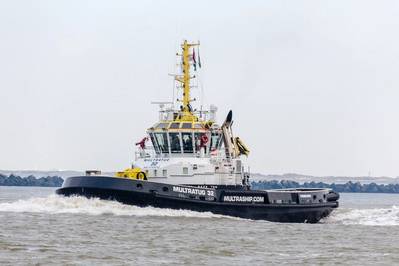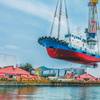First of Two New Tugs Delivered to Multraship
Towage and salvage specialist Multraship has taken delivery of the first of two new Carrousel Rave Tugs (CRT). The vessel, which was commissioned as Multratug 32 and delivered by Netherlands shipyard Damen Maaskant in Stellendam, will operate under lease to Multraship.
The contract for the vessels was agreed between Novatug, an arm of the group to which Multraship also belongs, and Damen’s specialist propulsion subsidiary Van der Velden Barkemeyer GmbH in November 2015. German shipyard Theodor Buschmann GmbH in Hamburg assembled the hulls, which were then moved to Stellendam for outfitting.
Multratug 32 is 32 meters long, has a maximum static bollard pull of 77 tonnes, and is powered by two Voith thruster units and two ABC main engines delivering 2,650 kW at 1000 rpm. Top speed is over 14 knots.
Damen said it is currently building a second, identical CRT for Novatug. Delivery is expected in May 2018 and the vessel has already been reserved for Multraship. Novatug also plans to market smaller versions of the CRT.
According to Damen, the new vessels will make it easier, safer and more environmentally friendly to work with seagoing vessels at much higher speeds than conventional tugs can safely achieve, and without the risk of capsizing under a tow-load.
Julian Oggel, managing director of Novatug, said, “The whole CRT concept was driven by safety considerations. In principle, capsizing is impossible when towing with the Carrousel, which facilitates the safe execution of maneuvers that would be very high-risk with traditional tugs.”
Oggel continued, “The Carrousel system consists of a base structure surrounded by a steel ring that can rotate freely through 360° in the horizontal plane. It carries a towing winch that can tilt vertically 45 degrees so that the winch can always be aligned with the towing line, providing optimal control. As a result, we can work with large seagoing vessels at much greater speeds than can be achieved by conventional tugs, and that means that the vessels themselves are easier to steer. This a major step forward for both efficiency and safety.”
Pepijn Nuijten, managing director of Multraship Towage & Salvage, said, “Thanks to the ingenious design of the tug, which effectively maximizes the use of the kinetic energy available in the towed vessel rather than the tug’s own engine power only, the same towing force can be achieved at much lower levels of fuel consumption than with a conventional tug.”
“The savings amount to at least 25 percent on an average operation involving a seagoing vessel. We have been using sustainable Eco2Fuel+ diesel from De Pooter Oil since trials began, resulting in emissions of soot and particulate matter being reduced by a further 16.5 percent, and a reduction in carbon emissions of 44.7 per cent compared with regular diesel,” Nuijten said.










